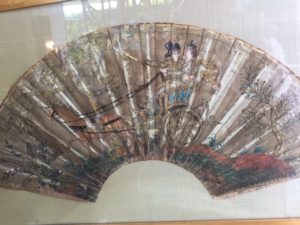 Gone are the days when a beautiful woman kissed the air and waved that kiss to a handsome man. Timely, then, that FG sent me a lovely, 200 years old, hand fan. Something to remind us of a time when the air carried only good messages.
Gone are the days when a beautiful woman kissed the air and waved that kiss to a handsome man. Timely, then, that FG sent me a lovely, 200 years old, hand fan. Something to remind us of a time when the air carried only good messages.
The language of the fan, developed and codified by women in the 16th century, conveyed unwritten messages. This little fan became extremely useful in flirtatious ways, because a lady couldn’t be seen speaking to a strange handsome man. Women didn’t address men as we do today, she used her fan to do that. Think of masques and plays and concerts, when people didn’t share words. A fan spoke for a lady in the way she showed, opened, or closed it. By the early 19th century gentlemen understood this message. A lost art form, FG’s little fan represents the language of seduction.
Hand Fan Language
The language of a fan held in capable hands in the 18th and early 19th century told a man what he wanted or didn’t want to hear. To hold a fan below your eye? ‘Come closer, I want to whisper something.’ To fan ones-self rapidly? ‘You make me hot and bothered!’ to fan yourself languidly? Go away, you bore me.’
FG sends me this gorgeous embroidered silk hand fan, which by its pleats shows a gentile woman once it as a folding fan. Folding fans are a fairly late development in the history of the fan. 3,000 years ago the rulers of Egypt owned scores of slaves wielding large solid fans to keep the hot air moving and to shoo away the flies.
Hand Fans From Asia in the 17th Century
Folding hand fans came composed of the leaf, the decorated part of the fan, and the support for the leaf, engineered to close the leaf, called the monture. Folds are accomplished with the aid of sticks, and the often-decorated ivory or wood or tortoise shell of the sticks topped with a guard. The hinge anchors the fan at the bottom, called the head.
The sticks changed in the very late 19th century with the invention of celluloid, and then again in the 1920s with the invention of Bakelite.
FG’s fan is painted and paper appliqued silk glued down in the late 18th century or early 19th century to paper. The outlines of the figures are tricked out in delicate sequins of gold. Believe me when I say these are not coated sequins, like today’s, but real gold. The outfits of the lady and the gent are outlines in silver sequins, also the real metal.
A Custom Early 19th Century Gift
This hand fan contains an Asian pedigree in its landscape design, but the applique in paper shows a Western couple in a Western horse-cart. The heads, done in painted paper, and applied to the fan, show the details of the faces specific to a couple in a historical time. I suspect a lady received this as a present from her lover who ordered it “customized” with their faces.
Perhaps the most interesting part of the costume design is the gent’s Regency style hat, with its upturned brim. From that I date the fan to the first years of the 19th century. The lady’s hairstyle indicates the Regency style, a simple fichu with a wrap of pearls over her head.
As the 19th century progressed hand fans became more ornate, and the simple elegance of this fan went out of style. By the Victorian era masses of dyed ostrich features were applied to sticks of ivory or tortoise shell. These ostentatious fans became much larger than the modest scale of FG’s hand fan. Because of the bio-degradable nature of feathers, few of these ostrich fans survive today. But we know of them through the painters of the French fashions of the third quarter of the 19th century.
The value of FG’s fan? A collector of Regency textiles, think Jan Austen fans (no pun intended), might pay $400 for this example.
Pingback: Vintage Fan Started with Ancient History - Elizabeth Appraisals